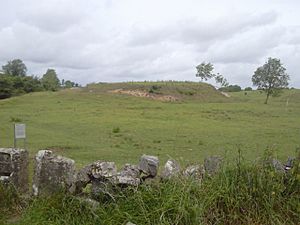Magh Adhair facts for kids
Quick facts for kids Magh Adhair |
|
|---|---|

Magh Adhair
|
|
| Location | County Clare, Ireland |
| Reference no. | 224 |
| Lua error in Module:Location_map at line 420: attempt to index field 'wikibase' (a nil value). | |
Magh Adhair (pronounced 'Maw A-dare') is a very old and important historical place in County Clare, Ireland. It's near the village of Quin, County Clare. For a long time, it was where the kings of Thomond, especially the O'Briens, were chosen and celebrated. The site has several ancient structures like a large mound, a tall standing stone, a cooking pit called a fulacht fiadh, and a special stone with hollows called a bullaun stone. Magh Adhair is a key spot for understanding the history and culture of County Clare and Ireland.
Contents
Discovering Magh Adhair's Past
Historians and archaeologists have not yet dug up or dated the Magh Adhair site. This means we don't know exactly when people first started using it. However, experts think the main mound was built a very long time ago. It could be from the Bronze Age or the Iron Age. This is because of the types of ancient monuments found there. It's likely that people used this site for at least 1,500 years.
What Does "Magh Adhair" Mean?
Some Irish historians, like John O'Donovan, believe the name "Magh Adhair" once meant a huge area. It might have even covered the whole "Clár" plain. This plain is where County Clare gets its name. Over time, the name "Magh Adhair" probably shrunk. It came to mean only the field where the monument stands today. It also included a nearby area called "Moyross/Moyree Park." The word "Ree" often comes from "rí," meaning king.
Ancient Stories and Trees
Magh Adhair is mentioned in old Irish records called the Irish Annals. For example, the Annals of the Four Masters tell us about events here.
In 981 AD, Maelseacchlainn, the son of Domhnall, attacked the area. He cut down the "Bile" of Magh Adhair. A "Bile" was a special Irish tree. It often had religious or magical importance. Cutting down such a tree was a very serious act. In 1051 AD, Hugh O'Conor also cut down the Tree of Magh Adhair.
Kings, Fairs, and Ancient People
Old records say that Amhalghaidh Mac Fiachrach built the mound of Magh Adhair. He wanted it to be his tomb. He also wanted his family to hold fairs around his mound. His heirs were to be made kings there. People continued to hold fairs, called "irachts," at Magh Adhair for a very long time. The last known fair was in 1838. Some say they might have continued until the Great Famine.
The mound is said to be named after Adhair, a chieftain from the Fir Bolg. The Fir Bolg were an ancient group of people in Irish legends. They were defeated by another mythical group, the Tuatha Dé Danann. The Fir Bolg were then pushed into an area called Connaught. At that time, Clare was considered part of Connaught. Later, the Milesians settled in Clare. They continued to use the site. These people eventually became known as the Dal gCais.
Magh Adhair is also mentioned in the Caithreim Thoirdhealbhaigh. This book tells the story of battles in the 13th and 14th centuries. It describes how chiefs gathered at Magh Adhair to make Dermot O'Brien their leader. This shows how important the site was for choosing kings.
Even though the O'Briens are strongly linked to Magh Adhair, the land was originally held by the O'Hehirs. Later, the MacNamaras took over. The mound has also been called "Cregnakeeroge." This name might come from "Ciaróg," which means an insect like a beetle.
What You Can See at Magh Adhair
Magh Adhair has several interesting features.
The Mound and Its Surroundings
The main mound is shaped like an uneven oval. It has been worn down a bit by cattle over time. A ditch, called a fosse, surrounds the mound. There's a path that crosses this ditch on the western side. This path leads to a flat area in the center of the mound.
Next to the main mound, to the west, is a smaller mound or pile of stones called a cairn. This smaller mound is stonier than the main one. The main mound is mostly made of soil.
Other Important Stones and Waterways
To the north of the main mound, you'll find a bullaun stone. This stone has two hollows that collect rainwater. North and west of this stone are some old enclosures. An old map also shows that a battle took place here in 877 AD.
The Hell river runs along the western edge of the entire site. Beyond the river, there's a tall standing stone, sometimes called a "ligaun." The main part of the site sits at the bottom of a natural bowl of low hills. This area can sometimes flood from the river. To the east of the site, there's a turlough (a lake that appears and disappears) and a fulacht fiadh (an ancient cooking pit).
The area around Magh Adhair is famous for its many ringforts. These were circular defensive settlements. The largest one nearby is Cahercalla, which has three rings.

